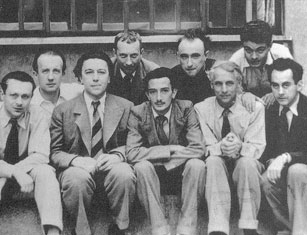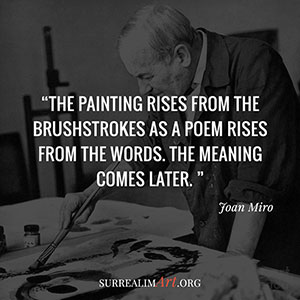The branches of surrealism

As various surrealist artists seek to recreate the dreamlike world, the other half of members indulges more into an art that’s bordering on, and which will contribute later to organize, the abstract expressionism.
Such an extensive movement that gathers so many artists together that surrealism cannot follow a very strict aesthetic line, or even a philosophical one: so many creative minds converging on the same theory are bound to diverge at some time or another. Moreover, the surrealism, whose three motto words are love, freedom, poetry, leaves room for inventiveness and originality.
First surrealist branch
The first branch, which could be considered illusionist, brings together artists such as Salvador Dalí, René Magritte, Yves Tanguy and Max Ernst. Less interested in dream interpretation than in a possible creative ability through these, illusionists want to create realistic representations of sleep state; in their work, the members of this branch of surrealism incorporate elements of nature, animals and even human figures. Nonetheless, like elephants on stilts or Dalí’s running timepiece, realistic elements as we know them often undergo changes out of the ordinary in these surreal paintings. The artists from this branch try to create discomfort in the viewer, either by distorting the ordinary or combining objects that have nothing to do with reality, like in The Hallucinogenic Toreador by Dalí, whose head is printed between two Venus de Milo, or even in the collective Invention by Magritte, which presents an absurd figure with the body of a fish and legs of man.
Artists who do not lean towards illusion rather incline towards abstraction. Among the supporters of the abstract surrealism are, for example, Joan Miró, André Masson, Roberto Matta and some works by Max Ernst, who is not listed in the illusion. The works in this branch of surrealism are characterized among other things by their acute automation, which eliminates any figurative representation, to allow the author - and by extension the audience - to understand by themselves the elements and the universe a piece. Playing with shapes and colors, l’Oiseau lunaire and other sculptures that Miró produced just after World War II are unlike anything else seen in sculpture before. In the 30s, just before World War II, several European artists, some surrealists, had to flee Europe for many reasons and thus embark to America. This wave of immigration will have some influence on the emergence, in the 1940s, in New York, of the abstract expressionism. The abstract surrealism will have been a transition from pure surrealism and abstract expressionism, in which shall misplace, the space of a canvas or two, from such great names as Jackson Pollock, Arshile Gorky and Robert Motherwell.
 Arts3 Network
Websites Edition
Other articles
The Automatistes Group
Surrealist Artists
Surrealist cinema
Arts3 Network
Websites Edition
Other articles
The Automatistes Group
Surrealist Artists
Surrealist cinema

“The painting rises from the brushstrokes as a poem rises from the words. The meaning comes later. ”
See more quote by Joan Miro
- History of Surrealism André Breton Branches of Surrealism Timeline Surrealist cinema The Automatistes Group Surrealism Manifesto Origin of surrealist painting Surrealist writing techniques
- Surrealist Artists Francis Picabia Jean Arp Joan Miro Man Ray Max Ernst
- René Magritte Biography Magritte & Lothar Wolleh
- Salvador Dali Biography Artworks Eccentric character Dali & Man Ray Dali & Picasso L'Âge d'or The Persistence of Memory The Hallucinogenic Toreador Movies Salvador Dali Museum


